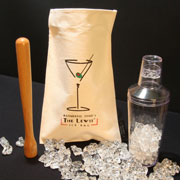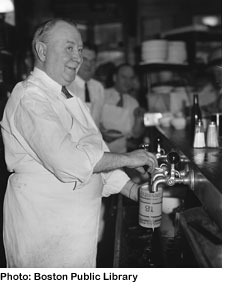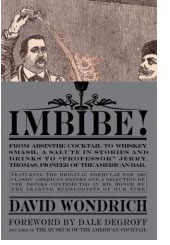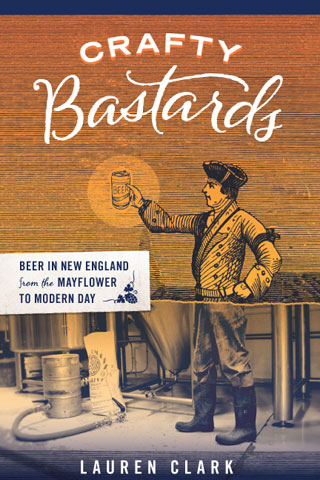Archive for the ‘Bartenders’ Category
February 29th, 2008

“Shake well with ice.”
The vast majority of recipes for straight-up cocktails instruct you to do this, but what does shaking (or stirring) “well” really mean? I occasionally give advice to home bartenders, and the main thing I find myself repeating is, “Shake/stir your cocktail until it’s really, really cold. You can leave a cocktail on ice longer than you think.” People are always surprised to hear this, because they heard somewhere once that bartenders are shiftless characters who will carelessly “water down” your drink unless you keep them on their toes. It’s not until these misguided drinkers have tasted a cocktail that’s been properly watered down, by a skilled bartender who knows his/her way around a shaker, that they realize what they’ve been missing during all those years of drinking tepid, poorly mixed booze.
But I find myself at a loss when the person I’m advising asks, “OK, but for how long do I shake the drink?” Well … it depends on the cocktail, the ice, the vigorousness of the shaking … In short, there’s not really a standard response. So I’m offering here the next best thing: expert advice. I posed these questions to several of Boston’s best bartenders: “How do you gauge when a cocktail’s cold enough — when your hand aches from holding the icy shaker? Do you count the number of shakes/stirs? For the home bartender’s sake, can you estimate the number of seconds (or even minutes) a typical cocktail should take to chill perfectly?” Their responses are below. Read them, and you’ll be able to wow the guests of your next cocktail party by demonstrating a “dry integration shake.”
NOTE: I didn’t really get into the whole matter of different types of ice, which some bartenders obsess over in their quest for the perfectly chilled drink. (That’ll be the subject for another day — this post’s long enough). That said, if you don’t have a Lewis Bag in your house, make sure you read to the end.
Rob Kraemer, Chez Henri
I go ’til my hand sticks to the shaker, probably under 20 seconds if shaking hard. Too long dilutes the drink fast, but I’m interested to see what other responses you get, as I don’t even think about it.
Ben Sandrof, No. 9 Park
As far as shaking a drink, I usually give egg drinks about a minute of shaking, unless of course it’s a fizz, in which case it’s a bit longer. If it’s a stirred cocktail, about 20 seconds does the trick. The key is that we are looking for approximately 20 to 30 percent ice melt in the cocktail, as well as the appropriate amount of chill. I could be a real nerd and tell you that there is a thermometer on hand to make sure the drinks are, as finished products, between 28 and 30 degrees, but let’s not go there yet…
Brother Cleve, freelance mixologist and cocktail historian
“When your hand aches from holding the icy shaker.” That’s really when I put it down. I recall going to the Blackbird in NYC when Dale DeGroff and Audrey Saunders were the bartenders, back in the late ’90s. I was really impressed with Dale’s shaking technique (over the shoulder, very fluid movements, and for a long time). I asked him about the length of time he would shake for, and he explained that he felt that the longer shaking time added, and mixed, the additional water the drink required to be balanced, especially since they used pretty large ice cubes. Generally, frost on the metal shaker indicates that it’s ready. I guess it works out to be a minute or two. I’ll shake longer if there’s dairy or eggs involved.
If I’m shaking with crushed ice, I do it for less time, as it adds more water at a more rapid rate. Same thing with blender drinks. Most tropicals should be done at high speed for five to 10 seconds, max.
Tom Schlesinger-Guidelli, Eastern Standard
In all honesty, I would say that both shaking and stirring are, at this point, second nature. It is really about feel, tasting a drink … is it balanced? Does it need more water to balance it out? Shaking or stirring are, at their most basic, about waterizing. I would say, in most scenarios, it is not necessarily about getting “appropriately cold” (though that is a wonderful secondary side effect). Instead, I think about properly waterizing that drink first, and how that usually offers you the proper temperature.
There are a number of different of types of shakes as well, each depending on what it is you are actually shaking. Many of Boston’s bartenders use a “dry shake” [a shake without ice, usually followed by a shake with ice] on egg drinks, arguing that it creates better texture in a drink. Some of us don’t necessarily buy into that philosophy. Then there is the “integration shake,” basically a quick two or three shakes, used to make the different liquids come together better. It’s one we use a lot, both for drinks like the Whiskey Smash, which ends up being strained over crushed ice, and for a lot of sparkling cocktails, like the Belle du Jour or even a French 75. In the Whiskey Smash example, you even use one further breakdown, a dry integration shake. It is for this reason that I think it is really hard to give an answer to “how long?” With a sort of mainstream everyday cocktail it is probably in the range of 30 or so shakes, maybe somewhere around 20 seconds.
In terms of stirring, I usually teach new bartenders to stir their cocktails until the shaker frosts over. That, to me, is kind of an easier distinction, particularly if you are stirring out of a [metal] shaker rather than a glass.
 Now, a piece of advice from little old me: Before you make a cocktail at home, crack your ice. The cubes from your standard freezer tray are nice and hard and dense — much better in quality than most “quick-melt” bar ice, I’ve heard bartenders say — but, with their smooth surfaces, they’re a little too slow to melt in your shaker. So empty a tray of cubes into your Lewis Bag, and give the bag a few hard wacks with the accompanying wooden mallet. Cracked ice + ample shaking/stirring time = great cocktails.
Now, a piece of advice from little old me: Before you make a cocktail at home, crack your ice. The cubes from your standard freezer tray are nice and hard and dense — much better in quality than most “quick-melt” bar ice, I’ve heard bartenders say — but, with their smooth surfaces, they’re a little too slow to melt in your shaker. So empty a tray of cubes into your Lewis Bag, and give the bag a few hard wacks with the accompanying wooden mallet. Cracked ice + ample shaking/stirring time = great cocktails.
Tags: coldness, ice, shaking, stirring, temperature, water
Posted in Bartenders, Cocktails, Drinking supplies | 5 Comments »
February 13th, 2008
 I have never met Walt Mates, but I plan to someday. Walt tends bar at Bistro La Belle in Midway, Kentucky. He is a fan of drinkboston, and I’d be lying if I said that didn’t influence my admiration of him. That and the fact that he stumbled upon this blog while researching the Saratoga cocktail. And the fact that his late father is from Somerville.
I have never met Walt Mates, but I plan to someday. Walt tends bar at Bistro La Belle in Midway, Kentucky. He is a fan of drinkboston, and I’d be lying if I said that didn’t influence my admiration of him. That and the fact that he stumbled upon this blog while researching the Saratoga cocktail. And the fact that his late father is from Somerville.
But what I really like about Walt is that he started his bartending career in midlife, after the bookstore he owned closed down a couple of years ago. Instead of being bitter about the transition, he found that he loves his new line of work. “I am very fortunate and thankful to have a boss who backs me 100 percent in offering carefully crafted classic cocktails using all fresh ingredients,” he says. And he likes his customers and co-workers, too! But recently, Walt emailed me to confide that he’s been feeling a bit peeved lately. He has been grappling with an issue that I think all bartenders deal with. He refers to it as “status anxiety.” Here’s what he wrote:
“I have already told you that what I have enjoyed the most about drinkboston are the interviews with and profiles of Boston’s best bartenders. What has struck me about so many of these individuals is that they seem to be Jacks and Jills of many trades and possess really varied and truly interesting backgrounds.
“I have been tending bar for a year and a half now, specializing in classic cocktails. Guests of the restaurant and my boss have been pleased and impressed with the drinks I prepare. And I can honestly say that I love my job. I treat and consider it as a craft and a profession. But I am beginning to experience a little status anxiety.
“Some people here in town who respected and eagerly interacted with me as a bookstore owner now treat me as a service worker. And while I realize that only shows how puny THEY are, at times I feel like shouting, ‘I am more than just a bartender!’ For heaven’s sake, your friend Misty is a Harvard Divinity School grad! As much as I love the job, I have been wondering whether it is ‘enough’ for me personally and professionally.
“To boil it down, I was wondering whether some of the bartenders you know, who have done and accomplished many different things over the course of their lives, have expressed this same restlessness.”
“Let’s put your question on the blog,” I said to Walt, and he agreed. So, bartenders, I’d love to hear your thoughts. Do some customers look down on you because you are a “mere” service worker? Do you ever feel the need to mention that you have other pursuits beyond mixing and serving drinks? Or do you simply dismiss as misguided anyone who believes that it’s impossible to find professional fulfillment behind a bar? Weigh in by leaving a comment below, or, if you’d rather not, email your words of wisdom to me and I’ll add them to the mix. Thanks!
Tags: Bartenders, career choice, respect, status
Posted in Bartenders | 17 Comments »
February 9th, 2008

By MC Slim JB
With this post, drinkboston introduces a new guest contributor, MC Slim JB. MC is a Boston-based writer whose honest, sharp restaurant reviews and food/drinks features have appeared in Boston Magazine, the Boston Phoenix, stuff@night, and the Weekly Dig. MC is also a frequent contributor to the restaurant review website Chowhound.
As a cocktail lover, I often sing the praises of my favorite bartenders’ technical chops: their ability to assemble well-balanced cocktails with speed and precision from the best and freshest ingredients, and to serve them with the right garnish, in the right glass, at the right temperature. But those skills are learnable. With enough training and practice, just about anybody can do those things well. A less transferable skill is the hospitality aspect of bartending, the person behind the stick’s ability to make each customer feel welcome, comfortable and well cared for.
I tried to think of a few small things that my favorite bartenders do that make me happy about my experience in their bars, and — having gotten accustomed to this kind of hospitality — that make me unhappy in places that don’t do them. Here are a few:
1. Acknowledge my presence with a word, a look or a nod when I first walk up to the bar. This way I know, even when it’s crazy-busy, that you’ll eventually get to me. That tiny bit of reassurance that I haven’t been lost in the crowd or deliberately ignored makes a big first impression.
2. Take the time, if you can spare it, to share my love of fine cocktails by talking with me about them. I love to hear more about the drink you’ve made me, the spirits and other ingredients that go into it, interesting variations on it, the lore and history surrounding it, who else makes a great one in town, suggestions for other cocktails you think I might like. I want my bartenders to share my fascination with cocktails and to be scholarly and passionate about their work, not just mechanics on an assembly line. (And for my friends who don’t care about that stuff, make and serve their drinks without fanfare or foofaraw.)
3. If I’m by myself, facilitate some interaction with other patrons. Share a story, talk up the game on the TV, make an introduction. Drinking isn’t much fun as a solitary sport, but not everyone is at ease striking up conversations with strangers, especially when traveling or in an unfamiliar venue. The bartender is in a unique position to bridge those social gaps, to help solo patrons feel a little less lonely and, incidentally, to offload some of the burden of entertaining them and so better tend to other customers.
4. When it’s time for me to go, give me an accurate check and bring my change or credit slip promptly. This is my last impression of your service before I leave a tip. It’s a good step to execute crisply.
There are hundreds of other little things that get bartenders onto my “awesome” list. Although thousands of people pass through his bar, Rob at the B-Side manages to remember my usual, even when I haven’t been by in months. No matter how busy it is at the bar at No. 9 Park, John always shakes my rye flip for five minutes. (Try this with a full shaker sometime to see how much work it is.) At Sasso, Casey invariably finds a way to get a conversation going between me and the rest of the bar. Every time I go by Green Street, Dylan has some innovative new concoction he’s itching to pour for me while expounding on its backstory. Sure, these folks are all great cocktail technicians, but it’s the way they make me feel like an important customer that inspires my loyalty. That’s what makes throngs of devotees follow them wherever they work. Hospitality skills are what separate the merely competent bartenders from the great ones.
Tags: MC Slim JB
Posted in Bartenders | 9 Comments »
October 31st, 2007
 Anyone wondering where our best bartenders got the inspiration to revive classic cocktails must read William Grimes’ article on Jerry “the Professor” Thomas in today’s New York Times, “The Bartender Who Started It All.” Specifically, it’s an article on Esquire magazine drinks correspondent David Wondrich’s new biography of Thomas, Imbibe. Grimes, himself a noted food and drink scribe, writes:
Anyone wondering where our best bartenders got the inspiration to revive classic cocktails must read William Grimes’ article on Jerry “the Professor” Thomas in today’s New York Times, “The Bartender Who Started It All.” Specifically, it’s an article on Esquire magazine drinks correspondent David Wondrich’s new biography of Thomas, Imbibe. Grimes, himself a noted food and drink scribe, writes:
“As Mr. Wondrich justly observes, Thomas, by departing from the code of the bartending fraternity and sharing his secrets, earned his place as ‘the father of mixology, of the rational study of the mixed drink.'”
Thomas lived from around 1830 to 1885 and wrote the first bartending book, variously titled the Bar-Tender’s Guide, How to Mix Drinks or The Bon-Vivant’s Companion. Don’t own a copy? You’re in luck, because bartender-blogger Darcy O’Neil of The Art of the Drink has published the Bar-Tender’s Guide (whose copyright has expired) online.
Posted in Bartenders, Books & resources | No Comments »
October 18th, 2007

Sean Holland was back on the stick temporarily last week at the Independent, a neighborhood restaurant well liked by Somervillians. Until he moved to L.A. in June to find fame as a musician, he could be found behind the bar at the Indo most nights of the week. What can I say? Scott and I miss the guy (sniff). As we settled onto our barstools for Sean’s guest appearance (filling in for the just-married Tanya — congrats!), I asked Scott what he was going to have and laughed when he said, “Whatever Sean wants. It’s his night.” Sean plunked a bottle of Saintsbury Pinot Noir and two glasses down on the bar, and off the evening went.
Sean’s a fine server, and I witnessed him hone his mixing skills on vintage cocktails, like the Gin and It, from the Indo’s smart drink menu. That he’s got some chops behind the bar is only the cake. The icing is that he’s highly entertaining, with a sense of humor that’s goofy on the outside and sharp on the inside. Sean and I are both from New Hampshire, and when I asked him once, without preface, which neighboring town he made fun of growing up, he knew immediately what I meant and answered, “Ossipee.” (Sean’s from Sandwich. For me and my fellow Gilford-dwellers, the town to mock was Belmont.) He has a knack for making you feel, even though he’s bringing you food and drink, like he’s just hanging out at the bar with you for some laughs.
Another knack of Sean’s is treating everyone with the same unaffected good humor. Some of the Boston-area’s most accomplished bartenders hang out at the Indo’s pub on their nights off. Sean never stooped to doting on them and forsaking other customers. And that’s one of the reasons they — and we — kept coming back.
Let us know when you’re making your next guest appearance, Sean, and good luck with the career.
Posted in Bartenders | No Comments »
 Now, a piece of advice from little old me: Before you make a cocktail at home, crack your ice. The cubes from your standard freezer tray are nice and hard and dense — much better in quality than most “quick-melt” bar ice, I’ve heard bartenders say — but, with their smooth surfaces, they’re a little too slow to melt in your shaker. So empty a tray of cubes into your Lewis Bag, and give the bag a few hard wacks with the accompanying wooden mallet. Cracked ice + ample shaking/stirring time = great cocktails.
Now, a piece of advice from little old me: Before you make a cocktail at home, crack your ice. The cubes from your standard freezer tray are nice and hard and dense — much better in quality than most “quick-melt” bar ice, I’ve heard bartenders say — but, with their smooth surfaces, they’re a little too slow to melt in your shaker. So empty a tray of cubes into your Lewis Bag, and give the bag a few hard wacks with the accompanying wooden mallet. Cracked ice + ample shaking/stirring time = great cocktails.


 Anyone wondering where our
Anyone wondering where our 
